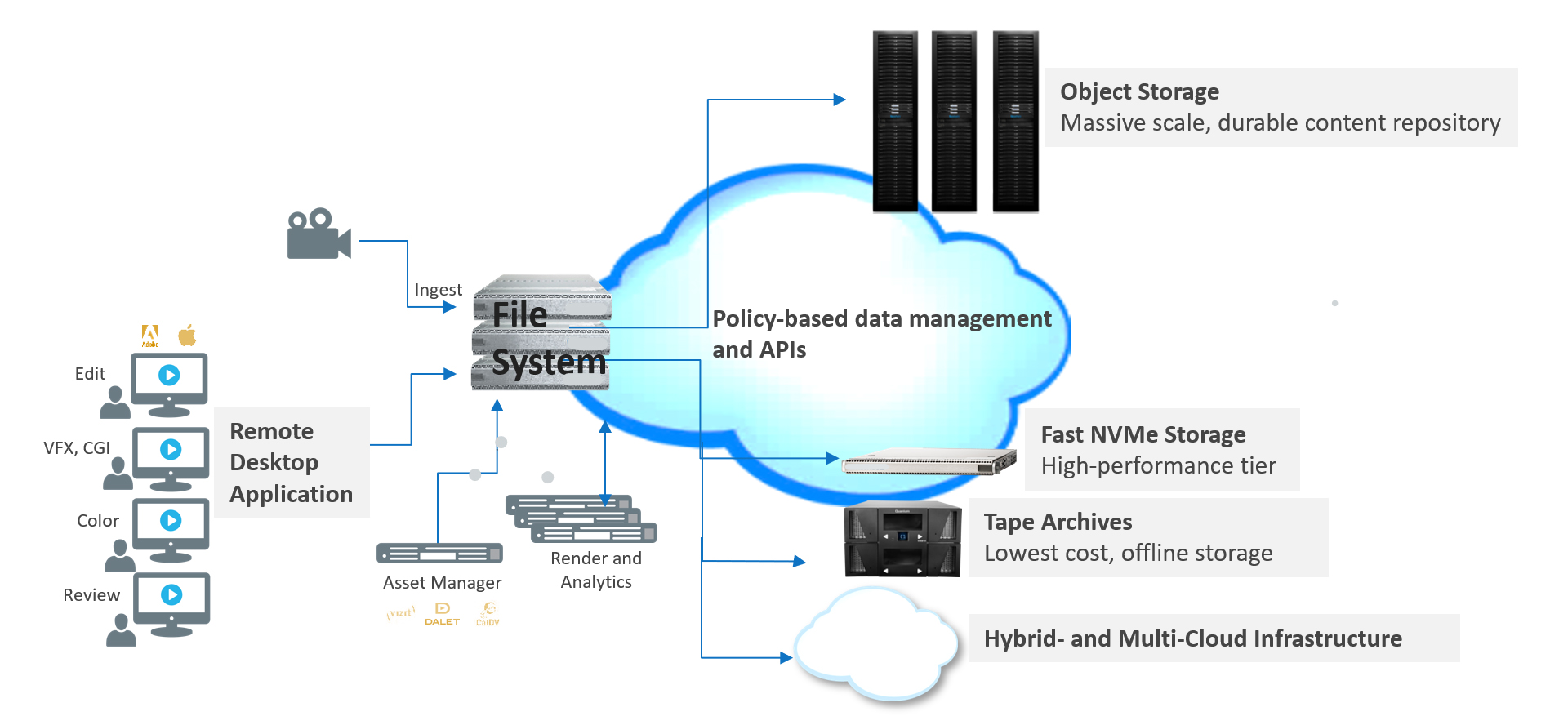Making Remote Production the New Norm
In video production, accessing and sharing content is critical

The concept of working remotely from our home studios is now generally accepted and integrated into our everyday lives. However, for the media and entertainment (M&E) industry, the transition to remote workflows has presented significant challenges from multiple angles, and had companies scrambling to find new ways to resume production as quickly as possible.
New and more efficient methods have evolved to help production continue. Essentially, this period has served as a catalyst for the evolution of remote production, which is now the “new normal.”
Remote production enables collaboration for geo-dispersed teams—colorists in Melbourne, VFX in London, editors in Los Angeles and others scattered globally—to contribute their artistry to complete the final product.
WORKFLOWS BEFORE REMOTE PRODUCTION
Creative teams and workflows have traditionally been in-house, working side-by-side in the same building over the same network and accessing content on local systems.
The storage infrastructure supporting these video workflows generally included a mix of disk, tape, object and cloud. The network infrastructures were generally slow but sufficient for on-prem access.
CHALLENGES WITH PAST METHODS
As production has shifted to remote offices, new challenges have arisen. Accessing and sharing large video files in distant repositories, including 4K and high-resolution content, have become crucial to the collaborative workflow.
Slower networks cause latencies and some file systems don’t support storage choices that optimize workflows, including fast NVMe for performance-driven projects and cost-effective tape, object and cloud for “cooler” content that doesn’t need to be accessed as frequently. Companies need a fast, centralized storage ecosystem to make it easy to find and share video content remotely.
The professional video industry's #1 source for news, trends and product and tech information. Sign up below.
Tip: Try RDMA networking for direct access to NVMe storage for reduced latencies and lower infrastructure costs.
DRIVERS FOR REMOTE PRODUCTION
There are many reasons for the rise of remote video production—primarily the increasing number of people now working from home. Today’s trend for repurposing previously created content, with creative work conducted remotely is another reason.
Additionally, the temporary shuttering of theaters has catapulted demand for streaming video content and accelerated the adoption of remote production to fulfill this market need.
Each scenario requires geographically distributed teams who rely on remote sharing and collaborative workflows and are dependent on technologies to support them.
OPTIONS FOR REMOTE PRODUCTION
Today, organizations are adapting their workflows to meet rapidly increasing demands for remote video content production. New methods provide content access and sharing to maintain business continuity and monetize the final product. Available options for remote production workflows include:
- Move to the cloud—While the cloud has its benefits, there are also other important factors to consider. Egress fees can add up quickly for retrieving large video files and moving content to and from the cloud can be prohibitively slow. Hybrid- and multicloud infrastructures can be more practical alternatives.
- Adjust workflows—This approach generally involves moving content and workflows around, which can be disruptive, potentially delay projects and risk content security. Additionally, transporting video content on shuttle drives between the studio and creative teams is neither efficient nor secure.
- Use existing infrastructure—Fast and generally simple to deploy, remote desktop technology provides access to the shared storage infrastructure. It requires minimal or no changes to the workflow, enables production continuity and reduces downtime. Virtual desktop technology gives organizations remote access to their existing file system and storage tiers, avoiding investments in all-new infrastructures.
Tip: Tiered storage architectures optimize resource utilization and facilitate remote access.
REMOTE PRODUCTION TODAY
Without new films or events to monetize, creative teams need to access, update and redistribute archived content. Entertainment companies are adjusting by moving the application to where the content is instead of moving huge amounts of video data around. In response, technologies offer remote production and editing capabilities with secure, virtual workspaces to handle graphics-intensive applications.
Remote desktop technology has been widely adopted for dispersed teams to seamlessly maintain creative workflows with access to their workstations and applications from their home studios. This is especially valuable when moving everything to the cloud isn’t feasible.
In video production, accessing and sharing content is critical. To help make this magic happen, the storage infrastructure is a key component in the workflow. With remote desktop technologies, organizations can use their existing storage ecosystem to streamline remote video workflows without interrupting the storage infrastructure.
Tip: Virtual desktop technology leverages the existing file storage system for ongoing remote access to large video files.
ADVANTAGES OF VIRTUAL DESKTOPS FOR REMOTE PRODUCTION
Remote teams require quick access to content, fast network speeds and reduced latencies to handle high-resolution video files. They need technologies that facilitate remote content sharing, enhance the collaborative process and minimize interruptions.
Ideally, they should use a file system with the fastest streaming performance, connectivity options and massive scalability. Storage tiering can also improve performance, like using object storage for a cost-effective storage pool that’s highly searchable and accessible.
Virtual desktop technologies provide flexibility to access video content from virtually anywhere. These workflows don’t impact the content storage infrastructure and provide file system access as local, which is especially beneficial for large files and streams like video.
It’s easy to see why virtual desktop technologies are widely used—they provide remote users with the same experience of their studio workstation at home.
THE NEW NORM OF REMOTE PRODUCTION
Handling large volumes of content remotely has presented challenges to media organizations. They’ve had to rapidly modify workflows, with remote production being a top priority for many. Remote creatives have needed to be able to access, share and deliver video content to maintain operational continuance.
There are different methods to continue production operations and choosing the right approach depends on each company’s objectives. Each method offers benefits with some having more costs and infrastructure changes associated with them. Sometimes the simplest alternative, which changes as little as possible, can be the best solution for highly productive remote workflows.
Tip: Work with a vendor expert in video and video-like data to understand what changes in your remote production workflows will be the most advantageous for your specific objectives.
Jessica Iler is the product marketing manager/StorNext for Quantum.

